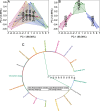Mitigating drought stress in fenugreek through synergistic effects of alanine and potassium-enriched biochar
- PMID: 39894802
- PMCID: PMC11789324
- DOI: 10.1186/s12870-025-06116-6
Mitigating drought stress in fenugreek through synergistic effects of alanine and potassium-enriched biochar
Abstract
Drought stress adversely affects plant growth, development, and yield. It can decrease seed germination, biomass accumulation, root proliferation, chlorophyll contents, and stomatal conductance. To overcome this critical issue, researchers suggest employing environmentally friendly approaches. The exogenous application of alanine (AL) acts as an osmolyte, which helps balance the cellular water under drought stress. It can also improve root architecture, biomass accumulation, and plant fertilizer use efficiency. Applying biochar can improve soil structure, water, and nutrient retention in soil, which are allied factors in enhancing plant growth under drought stress. Furthermore, the enrichment of potassium (K) in biochar also increases its availability to plants, directly regulating the stomatal conductance to alleviate drought stress. That's why the current study aims to explore the combined effect of AL and potassium-enriched biochar (KBC) on fenugreek cultivated under drought stress. Four levels of AL (control, 2mM, 4mM, and 6mM) were applied with 0%, 1%, and 2% KBC in three replicates. Results showed that 2mM AL + 2%KBC showed significant improvement in plant length (5.24%), plant fresh weight (25.36%), plant dry weight (16.23%), chlorophyll a (7.80%), chlorophyll b (15.83%), total chlorophyll (10.65%) over the control under drought stress. A significant increase in shoot N, P, and K concentration compared to control under drought stress also validated the effectiveness of 2mM AL + 2%KBC. In conclusion, 2mM AL + 2%KBC is an effective amendment for alleviating drought stress in fenugreeks. Under drought stress, growers are recommended to apply 2mM AL + 2%KBC to achieve better fenugreek growth.
Keywords: Alanine; Antioxidants; Biochar; Chlorophyll content; Drought stress.
© 2025. The Author(s).
Conflict of interest statement
Declarations. Ethics approval and consent to participate: We all declare that manuscript reporting studies do not involve any human participants, human data, or human tissue. So, it is not applicable. Study protocol must comply with relevant institutional, national, and international guidelines and legislation. Our experiment follows the with relevant institutional, national, and international guidelines and legislation. Consent for publication: Not applicable. Competing interests: The authors declare no competing interests.
Figures







Similar articles
-
Addressing cadmium stress in rice with potassium-enriched biochar and Bacillus altitudinis rhizobacteria.BMC Plant Biol. 2024 Nov 16;24(1):1084. doi: 10.1186/s12870-024-05793-z. BMC Plant Biol. 2024. PMID: 39548402 Free PMC article.
-
Evaluation of potassium-enriched biochar and GA3 effectiveness for Improving wheat growth under drought stress.BMC Plant Biol. 2023 Dec 5;23(1):615. doi: 10.1186/s12870-023-04613-0. BMC Plant Biol. 2023. PMID: 38049735 Free PMC article.
-
Alleviation of cadmium and drought stress in wheat by improving growth and chlorophyll contents amended with GA3 enriched deashed biochar.Sci Rep. 2023 Oct 28;13(1):18503. doi: 10.1038/s41598-023-45670-7. Sci Rep. 2023. PMID: 37898671 Free PMC article.
-
Biochar soil amendment on alleviation of drought and salt stress in plants: a critical review.Environ Sci Pollut Res Int. 2017 May;24(14):12700-12712. doi: 10.1007/s11356-017-8904-x. Epub 2017 Apr 3. Environ Sci Pollut Res Int. 2017. PMID: 28374202 Review.
-
Biochar as a tool for effective management of drought and heavy metal toxicity.Chemosphere. 2021 May;271:129458. doi: 10.1016/j.chemosphere.2020.129458. Epub 2020 Dec 28. Chemosphere. 2021. PMID: 33421912 Review.
Cited by
-
The Resistance of Germinating Pea (Pisum sativum L.) Seeds to Silver Nanoparticles.Plants (Basel). 2025 May 23;14(11):1594. doi: 10.3390/plants14111594. Plants (Basel). 2025. PMID: 40508269 Free PMC article.
References
-
- Li M, Xu Y, Fu Q, Singh VP, Liu D, Li T. Efficient irrigation water allocation and its impact on agricultural sustainability and water scarcity under uncertainty. J Hydrol. 2020;586: 124888.
-
- Kapoor D, Bhardwaj S, Landi M, Sharma A, Ramakrishnan M, Sharma A. The impact of drought in plant metabolism: how to exploit tolerance mechanisms to increase crop production. Appl Sci. 2020;10:5692.
MeSH terms
Substances
LinkOut - more resources
Full Text Sources
Medical

